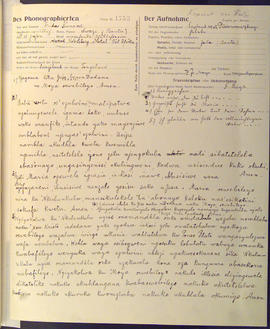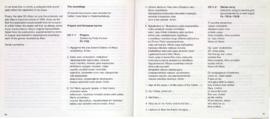Zone du titre et de la mention de responsabilité
Titre propre
FHYA collation of Series 10, The Collection of Father Franz Mayr: Zulu Recordings 1908 - sound recordings and associated material
Dénomination générale des documents
- Document sonore
- Document textuel
- Document iconographique
Titre parallèle
Compléments du titre
Mentions de responsabilité du titre
Notes du titre
- Source du titre propre: FHYA using ÖAW materials
Niveau de description
Série
Cote
Zone de l'édition
Mention d'édition
Mentions de responsabilité relatives à l'édition
Zone des précisions relatives à la catégorie de documents
Mention d'échelle (cartographique)
Mention de projection (cartographique)
Mention des coordonnées (cartographiques)
Mention d'échelle (architecturale)
Juridiction responsable et dénomination (philatélique)
Zone des dates de production
Date(s)
-
2016 - (Online curation)
Zone de description matérielle
Description matérielle
Zone de la collection
Titre propre de la collection
Titres parallèles de la collection
Compléments du titre de la collection
Mention de responsabilité relative à la collection
Numérotation à l'intérieur de la collection
Note sur la collection
Zone de la description archivistique
Historique de la conservation
[Source - Gerda Lechleitner for FHYA , 2016, using ÖAW materials: Franz Mayr was a Catholic missionary living and working in Natal between 1890 and 1909. Father Willem Schmidt, the editor of the anthropological journal ‘Anthropos’, and a member of the Austrian Academy of Sciences, suggested that Mayr and three other Catholic missionaries receive phonographs to preserve indigenous music from various parts of the world. According to Schmidt’s protocols Mayr made his recordings in September 1908. However Mayr’s own earlier publications suggest that these recordings were actually made before this date. Mayr used an Edison phonograph and wax cylinders to record songs in the Natal region of South Africa. This material was given to the Phonogrammarchiv at the then Imperial Academy of Sciences in Vienna (now known as the Austrian Academy of Sciences or the Österreichische Akademie der Wissenschaften). The Phonogrammarchiv copied the wax cylinders onto wax discs. They used the wax discs to make metal negatives. The wax discs were destroyed in a bombing during WWII, but the metal negatives remained. New casts, made from epoxy resin, were made by the Phonogrammarchiv, using these metal negatives. Following this, the recordings underwent a digitisation process. Franz Lechleitner, Nadja Wallaszkovits and Johannes Spitzbart transferred the original recordings to modern data storage media, edited them, and cleaned the signals from surface noises.
The transfer was done by means of electromagnetic stereo pick-ups. Every attempt was made to meet the standards of modern re-recording (use of high quality equipment, centring of the disc, careful choice of styli). The flat amplified signals of the stereo pick-up were stored as master transfers, serving as the source for further editing procedures. Generally, the speed indicated in the original protocols was chosen for the CDs. However, if the reference speed of the protocol was evidently incorrect, the speed was corrected to a more plausible value. Such corrections were always explicitly indicated. In order to prepare listeners for the historical sound quality, start grooves were faded in and end grooves were faded out. In the case of recordings featuring a sudden beginning or end, context noise was used for fading. As a matter of principle, no further signal processing was undertaken. However, in cases of extremely poor recordings, the Phonogrammarchiv took the liberty of adding an extra version where de-noising or another editing procedures allowed for partial improvements to the sound quality. Contents presumably extending across more than one phonogram were published as one single track, edited to represent one continuous recording, with each beginning of a phonogram being marked in the transliteration/ transcription, and in doubtful cases a short fading separated the individual recordings. They then produced master CDs. Gerda Lechleitner was the executive editor of this project. In 2006, Phonogrammarchiv published a complete version of the audio CD, along with an extensive CD booklet and Data CD.]
Portée et contenu
[Source - Chloe Rushovich for FHYA, 2018, using the CD booklet “Series 10 The Collection of Father Franz Mayr: Zulu Recordings 1908” and information provided by Gerda Lechleitner via email correspondence in 2016: The wide range of informants recorded by Mayr included young schoolgirls, an old "traditional" healer, non-Christian Zulu people, and Zulus who had already accepted Christianity and European customs (at least formally)
Mayr’s recordings were originally made with an Edison recorder on wax cylinders. This collection originally comprised of 50 recordings made by Mayr. However, the recordings listed in the first catalogue of the collection as Ph 1795A, Ph 1799A-1799B, and Ph 1800, no longer exist. Although these phonograms are missing from the Phonogrammarchiv, their original documentation still exists.
A book about Mayr, written by Clemens Gütl (Gütl, Clemens. ‘Adieu ihr lieben Schwarzen’: Gesammelte Schriften des Tiroler Afrikamissionare Franz Mayr (1865-1914). Vienna: Böhlau Verlag, 2004), prompted the Phonogrammarchiv to publish the Franz Mayr Collection in 2006.
Mayr’s original notes regarding the recordings were sporadic – in some cases he gave very few details about the interlocutor, while in other cases he was quite meticulous. In the case of interlocutors without a first or family name, or interlocutors with isiZulu names, this usually meant that the interlocutor had not converted to Christianity, where European-style names indicated an interlocutor who had converted to Christianity. Mayr had a wide range of interlocutors from the Natal area. Mayr stated that, with the exception of Ph 1773 [CD 2: 23] and Ph 1775 [CD 2: 24], which contain recordings in isiBhaca, considered by Mayr to be a dialect of siSwati, the recordings all document samples of isiZulu. Lechleitner notes that one should be cautious of sociohistorical context when approaching Mayr’s protocols. Importantly, modern research shows that the isiZulu spoken in Natal during Mayr’s stay was a specific dialect called the ‘Lala dialect’ or the ‘Tekeza language’.
The Mayr protocols are published on a data CD as digital images. They are divided into a protocol header and a free text section. The header contains standardised information such as: personal data of the phonographee, location and date of the recording, a brief summary of contents, technical details, as well as the phonographer’s name (and profession). The free text section contains texts, sometimes also translations and musical notations. Among these there may also be transliterations, unpublished or already published elsewhere, sometimes in historical transcriptions. Occasionally, one will also find texts which have not been recorded (e.g. additional verses of songs).
The series is arranged in 2 subseries for Disc 1 and Disc 2, and further laid out so that each song and the associated original protocols, transcriptions, and accompanying booklet is housed in a separate file.]
Zone des notes
État de conservation
Source immédiate d'acquisition
Classement
Audio and Data CD Information
[Source - The Collection of Father Franz Mayr Zulu Recordings 1908, CD booklet, 2006:
Audio CD1
Track 1- 3 Prayers and European hymns
4- 9 Music of Christian Zulus
10 -24 "Traditional" contents: wedding - hunting
Audio CD2
Track 1-22 "Traditional" contents: war-history
23 -24 Swati (Baca dialect): miscellaneous
Data CD:
The original protocols and transcriptions as image files]|
Langue des documents
Écriture des documents
Localisation des originaux
Disponibilité d'autres formats
Restrictions d'accès
Délais d'utilisation, de reproduction et de publication
Creative Commons License: CC BY-NC-ND
https://creativecommons.org/licenses/by-nc-nd/3.0/
Unless otherwise stated the copyright of all material on the FHYA resides with the contributing institution/custodian.
Instruments de recherche
Éléments associés
Accroissements
Note générale
Numbering principles
[Source - The Collection of Father Franz Mayr Zulu Recordings 1908, CD booklet, 2006: The consecutive archive numbers of the recordings do not contain any information about chronological relations among particular recordings of related contents. This numbering results from working conditions and other related factors and basically reflects the order in which the recordings were accessioned by the archive. Within the present edition, the recordings will therefore be arranged thematically by date. Possible deviation or exceptions from these general guidelines, which may prove necessary or favourable for certain series, will be discussed and explained in the introductory sections of the series in question.]
Identifiant(s) alternatif(s)
Zone du numéro normalisé
Numéro normalisé
Mots-clés
Mots-clés - Sujets
Mots-clés - Lieux
Mots-clés - Noms
- Five Hundred Year Archive (FHYA) ()
- Austrian Academy of Sciences (ÖAW) (Publication)
- Reverend Father Franz Mayr (Collection)




![Marian song: Descants, sung by several girls [accompanied by a reed organ], handwritten protocol](/uploads/r/austrian-academy-of-sciences-oaw/4/e/0/4e07249b9dff709f4a6cd903fd7b2975dcf8316b80a028e353be92b11ffb4f41/OAW_Mayr_1908_The_Collection_of_Father_Franz_Mayr_Zulu_Recordings_handwritten_protocol_Ph_1761A-1761B_142.jpg)
![Marian song: Descants, sung by several girls [accompanied by a reed organ], lyrics transcript and...](/uploads/r/austrian-academy-of-sciences-oaw/0/0/e/00e506d03cd1032f5712d9753bf078408cad22c156dbc3ca3e37caaef5a5ee50/OAW_Mayr_1908_The_Collection_of_Father_Franz_Mayr_Zulu_Recordings_lyrics_transcript_and_translation_Ph_1761A-1761B_p41_142.jpg)
![Hymn Descants, sung by the same girls [as in Ph 1761; accompanied by a reed organ], handwritten p...](/uploads/r/austrian-academy-of-sciences-oaw/8/1/1/8111917636b3bb54fd93a460b591fcb288311d5399aaf993b962760cda167dea/OAW_Mayr_1908_The_Collection_of_Father_Franz_Mayr_Zulu_Recordings_handwritten_protocol_Ph_1762A-1762B_142.jpg)
![Hymn Descants, sung by the same girls [as in Ph 1761; accompanied by a reed organ], lyrics trans...](/uploads/r/austrian-academy-of-sciences-oaw/e/e/a/eea3ee4f9298e31b4a3dc1cea8384e31bad13b0c0c6991767a5a5447ce18cee4/OAW_Mayr_1908_The_Collection_of_Father_Franz_Mayr_Zulu_Recordings_lyrics_transcript_and_translation_Ph_1762A-1762B_p42_142.jpg)
![Hymn Descants, sung by the same girls [as in Ph 1761; accompanied by a reed organ], music notation](/uploads/r/austrian-academy-of-sciences-oaw/b/1/d/b1d25828814813b710a99f442a3b6df1eeed3d303cdfee5e04d710f84565fa8b/OAW_Mayr_1908_The_Collection_of_Father_Franz_Mayr_Zulu_Recordings_music_notation_Ph_1762A-1762B_142.jpg)
![Umququmbelo: dance song [of the Christian Zulus] Three-part singing by four grown-up girls, handw...](/uploads/r/austrian-academy-of-sciences-oaw/9/3/6/936885cff378b32d1fcc17b8b9dafbf8103bf93bc5547acd74398f2ab85cdfd3/OAW_Mayr_1908_The_Collection_of_Father_Franz_Mayr_Zulu_Recordings_handwritten_protocol_Ph_1754r_142.jpg)
![Umququmbelo: dance song [of the Christian Zulus] Three-part singing by four grown-up girls, handw...](/uploads/r/austrian-academy-of-sciences-oaw/6/3/1/631a6dd63cdcafd5cfba94204e0fc65367f21e85ada8db1cb0d946bd616570e8/OAW_Mayr_1908_The_Collection_of_Father_Franz_Mayr_Zulu_Recordings_handwritten_protocol_Ph_1754v_142.jpg)
![Umququmbelo: dance song [of the Christian Zulus] Three-part singing by four grown-up girls, lyric...](/uploads/r/austrian-academy-of-sciences-oaw/e/e/a/eea3ee4f9298e31b4a3dc1cea8384e31bad13b0c0c6991767a5a5447ce18cee4/OAW_Mayr_1908_The_Collection_of_Father_Franz_Mayr_Zulu_Recordings_lyrics_transcript_and_translation_Ph_1754_p42_142.jpg)
![Umququmbelo: dance song [of the Christian Zulus] Three-part singing by four grown-up girls, music...](/uploads/r/austrian-academy-of-sciences-oaw/4/d/9/4d9fb23fe087f923c967d51f4614505c17a899253b9f9d4f7f2745246f015e78/OAW_Mayr_1908_The_Collection_of_Father_Franz_Mayr_Zulu_Recordings_music_notation_Ph_1754__142.jpg)
![Umququmbelo: dance song [of the Christian Zulus] Four-part singing by grown-up Zulu girls, handwr...](/uploads/r/austrian-academy-of-sciences-oaw/6/e/9/6e92046b07782c120f448ceb9912f74c87eabf823e9c03ced8a446f1300f8d60/OAW_Mayr_1908_The_Collection_of_Father_Franz_Mayr_Zulu_Recordings_handwritten_protocol_Ph_1755r_142.jpg)
![Umququmbelo: dance song [of the Christian Zulus] Four-part singing by grown-up Zulu girls, handwr...](/uploads/r/austrian-academy-of-sciences-oaw/b/7/1/b716f48fb3dae4a893852439961af8787225639182ceabdcd232e7985c19ed6a/OAW_Mayr_1908_The_Collection_of_Father_Franz_Mayr_Zulu_Recordings_handwritten_protocol_Ph_1755v_142.jpg)
![Umququmbelo: dance song [of the Christian Zulus] Four-part singing by grown-up Zulu girls, lyrics...](/uploads/r/austrian-academy-of-sciences-oaw/e/e/a/eea3ee4f9298e31b4a3dc1cea8384e31bad13b0c0c6991767a5a5447ce18cee4/OAW_Mayr_1908_The_Collection_of_Father_Franz_Mayr_Zulu_Recordings_lyrics_transcript_and_translation_Ph_1755_p42_142.jpg)
Material contributed by members of the public
Building an archive is a collective endeavour. Please help us grow the FHYA knowledge base.
If you want to add information to this page you can insert a hyperlink, add files and/or text to the box below.
In the case of material relevant to the FHYA as a whole please upload information HERE.
The FHYA does not vet this material but reserves the right to remove anything deemed to be racist, homophobic, sexist or otherwise offensive. Everything on the FHYA is licensed under a Creative Commons CC BY-NC-ND licence.
To make a contribution you must be a registered user. To register an account, click here. Note that after registration you will not be automatically redirected to this page.
If you have already registered but are not logged in, log in here.